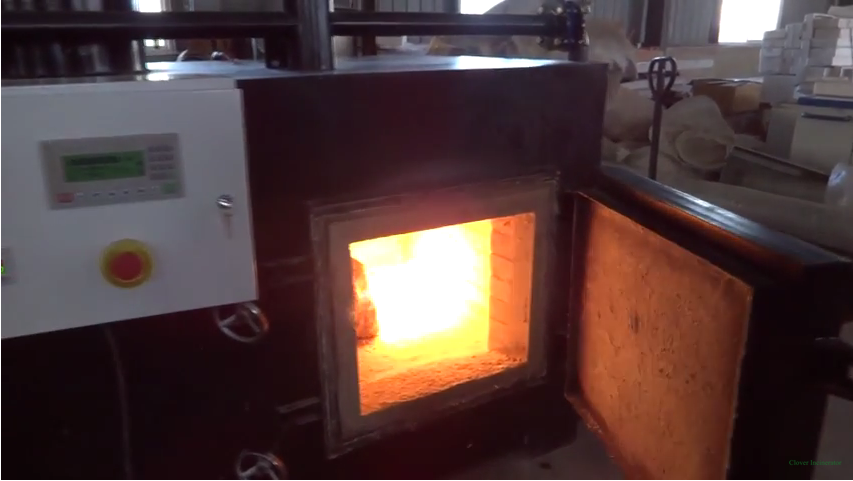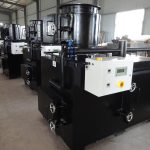Incinerator electrically operated
including:
A cage for receipt of biomedical waste;
A combustion chamber with fireplace with a filter to retain ashes;
A cover;
An air supply;
A turbine allowing supply air.
Combustion temperature: 1800 ° C.
Comes with all accessories

• Installing a readymade concrete base (Precast) with Height 30 cm above the ground and 20 cm below the surface of the earth.
• The dimensions of the base are increased by (2 meters) from the edge of incinerators
• The rest of the accessories in all the trends even allows the worker directly feeding and maintenance work, cleaning and move easily taking into account the tendencies of the base toward the door for drainage of water.
• The floor coating must be high-quality epoxy paint.
• Install anti-rust and heat Umbrella of brick and steel (pyramid shape) of (5) meters height above the ground which installed with the edge of the concrete base by thick galvanized columns
• This umbrella Cover the site furnace and allow bringing the chimney
• The site is surrounded by an iron fence (sheet metal) 3 meters height from the surface of the earth in order to protect the incinerators from dust storms
• The iron fence must have a 5 meters Width gate

• Automatic anti-rust and heat electrical circuit must be provided
• The furnaces are highly efficient, emissions-free, safe, and environmentally friendly and have capacity of not less than 3,000 kg of materials and the rate of burning at least 400 kg / h
• The method of feeding the furnace through a side slot or from the top and the emission of the smoke is completely prevented.
• a furnace Must have two rooms, one of them is the main room of not less than the “5” stoves to the process of burning materials and other secondary room of not less “2” stoves to burn resulting gas from the first process as well as the chimney
• The main component of the body of the furnace is stainless steel box, the thickness of not less than 7 mm with a layer of zinc phosphate plated with aluminium reflector to heat
• the thickness of the door of 150 mm and a hardness of not less than 170 kg / m 3 to be burnt, automatic comprehensive remote system.
• Furnaces must be destructive enough to burn and incinerate the material which mentioned previously
• furnaces must have certificates are supported global enterprises and government competent for environmental protection In the country of origin or the General Presidency of Meteorology and Environment Protection in Saudi Arabia
• The oven can work for 24 hours so as to allow for the burning of materials for a period of not less than 12 consecutive hours and the remainder for cooling and provides full fuel tank with a capacity of 1000 L to turn on the oven.
• Must have an automatic ignition and diesel is used
• a furnace has the ability to withstand extreme temperatures up to “130o c And also, it guarantees continuous operation of which can be utilized for 24 hours with the ability to remove residues during the work of the oven, Insulating layer of calcium must be present in the rooms with Thickness not less than 50 mm and a wall thickness of 100 mm
• Isolation of burning room: the space between the walls must be of the “stainless steel”. In addition, burn room must fill with Thermal insulation material.
• Ensure that the combustion of materials emitted in the secondary room should be at least two seconds period and the room is lined with high-density ceramic fibbers
• Incinerators must contain a system for processing (purification) gasses before emission of the smoke.
• Incinerators must have the capacity of self-cooling after the end of the daily operating period.
• Incinerators must have chimney not less than “4 meters” height from the surface of the oven, also, it must be thermally insulated and non-rust able, and must also be removable, installation and tide default.
• Electrical capacity required “220/ 380-volt “60 hertz
• Incinerators must be fitted with a control panel of the electronic keys to monitor all the necessary indicators of activation keys, as well as start-up and switch off so as to be isolated inside a metal box with the presence of the following:
Alarm Sensor in the event of (crashes “burner” or purification device or heat leakage or internal connections and wiring)
Monitors for the temperature of the rooms

Aerosols Filter indicators/ monitors
Room temperature sensors
Indicators for furnaces and index overload
Timer for Extinguish the oven automatically depending on the time required.
• All equipment must be highly resistant to external conditions such as high temperature (50oc)
• All doors must have special lock are not allowed non-persons appointed to work.
• Providing fire extinguisher for each site with a capacity of 10 kg at least
























